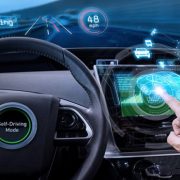The accessibility of driverless cars
Driverless vehicles: does autonomy equal inclusivity?
Senior UX Consultant, Chris Bailey, takes a look at autonomous vehicles – driverless cars – one of the hottest topics in technology right now.
We are already being sold a vision by vehicle manufacturers of these intelligent, luxurious, spacious vehicles acting not only as transport – but as spaces of work, leisure and pleasure. As UX professionals, we’re interested to see how producers ensure the accessibility of driverless cars.
A fundamental shift in the product UX
As part of the usual ‘Hollywood Effect’, we’re being sold a perfect product experience, but for other individuals the impact of these vehicles from an accessibility viewpoint could be huge – more on that later.
We note that in media articles these products are not being referred to simply as ‘concept’ vehicles, but also ‘research’ vehicles. It’s really encouraging to hear companies acknowledging the importance of research. One of the reasons for this, is that they know they have to get the UX spot-on.
Cars are an especially emotive product, and the user experience is about to change fundamentally: we’re going to be moving from being in control, to almost completely giving up that control. Research is required to make sure the technology will work for all users. And it will take time for all users to accept this change!
Autonomous vehicles bring many considerations for us as UX professionals, and as for the emergence of any new technology, we want to highlight the huge potential they have for enhancing accessibility. With approximately 20% of the UK population having some form of disability, many people could benefit from these enhancements.
The effects of a disability, and the potential benefits of autonomous vehicles
The effects of a disability may not just be physical or cognitive, but also emotional and psychosocial. A person with a disability is far less likely to be in full-time employment, and is more likely to rely on others for support with day-to-day tasks such as attending medical appointments, and to experience social isolation. This can often affect a person’s self-confidence and self-esteem.
Driverless cars promise new transport opportunities – reducing the stress of having to rely on public transport, and giving control back to individuals. They may also reduce the burden on local authorities responsible for providing day-to-day care and other services to people with disabilities.
A milestone in the accessibility of driverless cars?
In what was described as a ‘milestone journey’, Google recently reported that a blind passenger travelled unaccompanied in a fully automated vehicle in Austin, Texas. The passenger himself stated “This is a hope of independence. These cars will change the life prospects of people such as myself. I want very much to become a member of the driving public again.” Individuals with a range of physical and learning disabilities will surely also benefit greatly from this technology.
People may also find they need to give up driving as they get older, or because of a medical condition such as a stroke, which can cause similar issues of entrapment regarding sudden loss of independence. Given our ageing population, this is something we may all soon benefit from.
Implementing a social model of disability

Driverless cars may just prove the key to society being able to implement the social model of disability, rather than the medical model. A person is only as disabled as the society around them – and driverless cars could be a great equaliser.
Can the accessibility potential be realised?
While the potential of automated vehicles to bring freedom and independence through transport is clear and we should be excited about their arrival, manufacturers must consider the specific needs, expectations and desires of users with accessibility requirements from the outset. No matter what the potential of the technology if it’s not accepted by users, it won’t be a success – remember Google Glass?
Users with a wide range of accessibility requirements should be involved at all stages in the process; from requirements gathering, concept design to prototype development. History has taught us that this is the only way to ensure that that the accessibility of driverless cars is maximised.

Contact our accessibility consultants for expert advice and services
